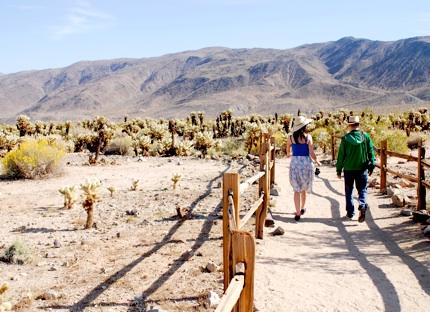While there are many long-distance hikes you can take in Joshua Tree National Park, sometimes the heat can just be too much. But even if it's the middle of the day, a stroll down the Cholla Cactus Garden path is well-worth your time to learn about these curious cacti.
The "garden" is located 20 miles north of the park's Cottonwood Visitor Center along the Pinto Basin Road and is at the south end of Wilson Canyon. The small forest of chollas lies just south of the geographical break between the Mojave Desert to the north and the Colorado Desert to the south.
The Mojave is a higher, cooler desert more attractive to Joshua trees, Mojave yuccas, even pinyon pines, scrub oaks, and junipers. The Colorado Desert, a fragment of the much larger Sonoran Desert, is below 3,000 feet in elevation and is hotter than the Mojave. This setting is more favorable for cholla, ocotillo, and creosote bush.
A stop at the Cholla Cactus Garden rewards you with a level, quarter-mile nature trail that introduces you to a beautiful collection of "jumping" cacti, a nickname the cholla picked up for their propensity to insert their spines into your skin at the lightest touch. That's definitely something you should mention to all in your party -- particularly children -- before you head down this path.
Another nick-name for this cactus is the "teddy bear" cholla, which one cholla variety picked up for the silvery bristles they seem to be covered with.
Walk the meandering pathway through this cactus garden and you'll encounter not only the so-called Jumping Teddy Bear Cholla, but also the Silver Cholla, and the Pencil Cholla. Interspersed among these cacti are a number of other hot-desert-loving plants, such as hedgehog cactus, climbing milkweed, jojoba, and creosote bush.
But it's the cholla that will draw most of your attention, both due to their beautiful arrays of spine-bristling branches as well as the sheer numbers of them in this section of Joshua Tree. According to the trail pamphlet you can pick up at start of your walk, the abundance of cacti in this location is the result of a reliable water supply at key times of year for the plants.
Such conditions exist in the higher desert ranges and on many of the alluvial fans, where washes carry the rapid runoff of summer cloudbursts and winter rains. Loose gravel and rock crevices, where water percolation is good, are necessary for prolific growth. This well-drained slope is one of only a very few places within the park which exactly meets the needs of the teddy-bear cholla. Very few cacti of any sort are found at lower elevations in the Pinto Basin due to highly compacted sand and gravel.
Walking through this garden, you can easily get the impression from dark brown trunks of some cholla that many of them are dying. That's not the case at all, according to park botanists. Rather, these sections draw their color from dead spines, while the rest of the plant is generating new growth. And that leads to another interesting aspect of the cholla.
As new joints become older, they detach readily from the parent plant. This is one of nature's most effective methods of vegetative reproduction. The detached joints will quickly develop roots and grow into new individuals.
While you can visit this garden any time of year, the cholla come to bloom with delicate white petals with red tips in mid-April.
After you've negotiated the loop, you might want to consider heading another mile or so south on the Pinto Basin Road towards the Cottonwood area to stop at the Ocotillo Patch. Though not as dense as the Cholla Garden, the spindly, 20-foot-or-so-tall ocotillos are beautiful to see, particularly in mid-to-late April when they're abloom with flashy red flower spikes.




Add comment